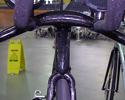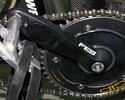
Recently on Cyclingnews.com |
Tech news for December 4, 2007Edited by Paul Verkuylen Got tech? Send press releases, news, and tech questions to the Cyclingnews tech desk. |

|
The German national squad showed up to the first round of the UCI Track World Cup in Sydney, Australia with a stacked deck of innovative technology developed in house at FES (Research and Development of Sporting Equipment). The science institute has been tasked with developing tools that will help the Germans gain an advantage over their competition, and included in that toolbox for Sydney was a new frame, handlebar, and power measuring crankset.
The aerodynamic-looking carbon fiber frame and integrated handlebars look interesting enough, but the novel crankset was easily the most intriguing piece of kit. Unlike systems currently on the market that use a single group of sensors (located either in the rear hub, chainring spider, or bottom bracket) to measure left- and right leg power output, the FES unit houses sensors in each crankarm, just upstream of the pedals.
The power measuring hardware fits wholly inside each crank arm so as not to interfere with the aerodynamics of the bike. According to FES, the tidy package measures power, cadence, and speed, all from a unit that employs no other externally visible sensors. There is also no visible display; data is exclusively extracted by computer download through a cable located at the top of the seatpost.
"We develop the bikes, the handlebars, as well as the cranks. We also develop the software so that we can visually show what is going on," said FES engineer Kay Schubert while sitting in the stands. "We want to know everything: how much power they have at the start, as well as the difference between the power on the turns and the straights."

|
Trainers can view individual rider data, as well as overlay the data from all four riders during a team pursuit. "That way we can see what sort of power the guy in front is generating at the same time we can see what the last guy is doing," said Schubert.
In theory, the discrete sensor configuration should yield a more accurate representation of individual left vs. right leg outputs. The FES system may also prove to be more accurate overall as power is measured at almost the precise location that power is applied.
Schubert wouldn't reveal the exact type of technology FES is using, but he did suggest that it was something that is not currently used by other power meters. "We are collecting different type of data than what we can get from [SRM]," he said.
In addition to the decidedly mysterious power meter, the German team mechanic also hinted about a new pursuit bike, saying that new bikes have been developed but are not to be used just yet in order to keep them secret from their competitors. "Maybe in Beijing next week, you will see one," he informed us. Stay tuned…
![]()
Photography
For a thumbnail gallery of these images, click here
Images by Paul Verkuylen/Cyclingnews.com
- The carbon fiber dropouts include built-in adjuster screws for more precise chain tension and are also knurled to virtually guarantee that the wheel won’t slip under power.
- Power, speed, and cadence data s accessed exclusively by computer download. There is no external display for the rider to watch.
- The German national team’s carbon fiber handlebars are a product of FES, a German science institute charged with developing equipment that provides the team with functional advantages over its competition.
- Straight carbon fiber seat stays are presumably designed with stiffness and aerodynamics in mind.
- The aero-shaped seatpost is secured by a hidden bolt.
- These guys are collecting a lot of important data for their riders.
- The FES power meter hardware is wholly located within the crankarm.
- Another unit is hidden in the other crankarm.
- The front wheel is attached to the proprietary carbon fork via a tidy thru-bolt for cleaner aerodynamics.
- The old-school Dura-Ace SPD-R clipless pedals re still a favorite on the track for their extra-secure hold, which in this case is augmented by a double toe strap secured to the back of the pedal with a custom bracket.
- The front of the German team bikes are clean and unfettered.

